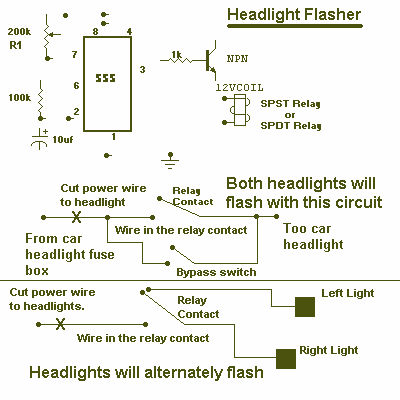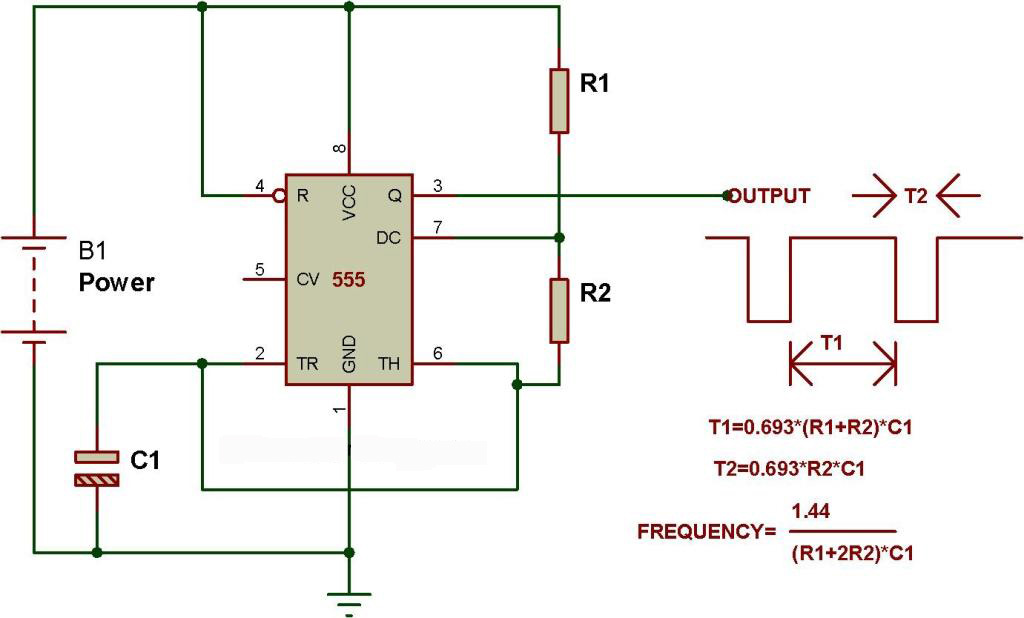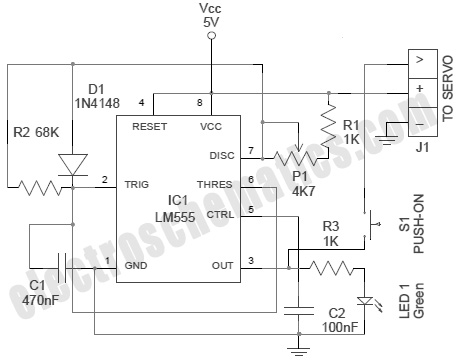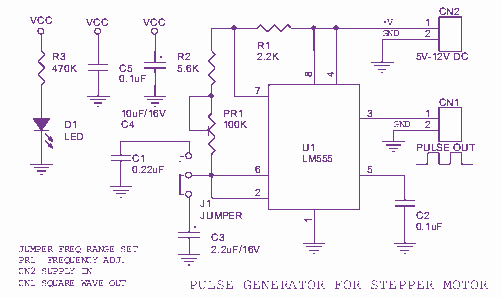
FM Moulator with IC 555

The FM modulator circuit is a straightforward FM modulation design utilizing the IC 555, where the resulting modulated signal is dependent on the frequency of the input signal. The output signal is stable and of good quality, eliminating the need for inductors or windings, thus simplifying the construction process. The desired frequency modulation can be achieved by adjusting the frequency of the IC 555, which is primarily determined by a resistor of 6.8 kΩ, another resistor of 3.3 kΩ, and a capacitor of 0.1 µF. To obtain different frequencies, one or all of these components can be replaced. Although the FM modulator circuit using the IC 555 is simple, it is sufficiently reliable for basic applications that do not demand high power or high-frequency output. For increased power, an RF amplifier can be added to the output of the circuit, enhancing the modulated signal. Experimental results indicate that the modulator functions effectively at frequencies below the MHz range, as the IC 555 is not designed for very high frequencies. For applications requiring higher frequencies, alternative methods such as oscillator transistor circuits or crystal oscillators can be employed. The primary distinction between this circuit and a standard multivibrator circuit is the use of pin 5 on the IC 555, which serves as the input for the information signal that modulates the output signal. In typical multivibrator applications, pin 5 is usually connected to a 0.01 µF capacitor or left unconnected.
The FM modulator circuit employing the IC 555 is designed to facilitate the modulation of audio signals onto a carrier frequency, allowing the transmission of sound over radio frequencies. The core of the circuit consists of the IC 555 configured in astable mode, generating a square wave output that can be varied based on the input signal fed into pin 5. The frequency of oscillation is determined by the resistors and capacitor connected to the IC. The values of the resistors (6.8 kΩ and 3.3 kΩ) and the capacitor (0.1 µF) can be adjusted to produce different carrier frequencies, making the circuit versatile for various applications.
The absence of inductors simplifies the design, making it accessible for hobbyists and beginners in electronics. The circuit can be powered with a standard DC supply, typically ranging from 5V to 15V, depending on the specific requirements of the application. The output can be connected to an antenna for transmission, and the addition of an RF amplifier can help boost the signal strength for longer-range transmission.
In practical applications, this FM modulator can be employed in short-range wireless audio transmission, allowing audio signals from devices such as microphones or music players to be transmitted to FM receivers. The circuit's simplicity and effectiveness make it a suitable choice for educational projects and basic communication systems. However, for applications requiring higher fidelity, power, or frequency stability, more sophisticated modulation techniques and components may be necessary.FM Modulator circuit is a simple FM modulation circuit using IC 555, where the resulting modulated signal has a tenuous meeting depends on the signal frequency information. The resulting signal can be spelled out quite nice and stable so that the result will be more perfect.
No winding or inductor in series modulator, so you do not need to bother to make a winding and calculate the value of the coil that you created it. With this circuit the desired value of frequency modulation can be obtained easily by calculating the frequency of IC 555 in general, which is determined by the resistor 6. 8 K and 3. 3 K and 0. 1 UF capacitor. To obtain the other frequencies of your stay replace one or all three components. Actually fm modulator ic 555 circuit is very simple though, but I think it reliable enough to handle a simple application purposes that do not require a big power or a very high frequency.
But if you want more power you can add the RF amplifier circuit at the output of this circuit. Thus, the results of modulated signal can be amplified with the help of a series of supporters. In accordance with my experimental series modulators can work well at frequencies below the MHz range, because it is not IC IC 555 which is devoted to support of a very high frequency. You can use oscilltor transistor circuit, XTAL or others if you need a very high frequency. The difference circuit with IC 555 on the multivibrator circuit in general is the use of pin 5, on the FM Modulator circuit is pin 5 of IC 555 is used as input information signal, which in turn will influence the shape of the output signal (modulated).
But in applying this 5 pin multivibrator functions normally associated with 0. 01 UF capacitor or left alone. 🔗 External reference
The FM modulator circuit employing the IC 555 is designed to facilitate the modulation of audio signals onto a carrier frequency, allowing the transmission of sound over radio frequencies. The core of the circuit consists of the IC 555 configured in astable mode, generating a square wave output that can be varied based on the input signal fed into pin 5. The frequency of oscillation is determined by the resistors and capacitor connected to the IC. The values of the resistors (6.8 kΩ and 3.3 kΩ) and the capacitor (0.1 µF) can be adjusted to produce different carrier frequencies, making the circuit versatile for various applications.
The absence of inductors simplifies the design, making it accessible for hobbyists and beginners in electronics. The circuit can be powered with a standard DC supply, typically ranging from 5V to 15V, depending on the specific requirements of the application. The output can be connected to an antenna for transmission, and the addition of an RF amplifier can help boost the signal strength for longer-range transmission.
In practical applications, this FM modulator can be employed in short-range wireless audio transmission, allowing audio signals from devices such as microphones or music players to be transmitted to FM receivers. The circuit's simplicity and effectiveness make it a suitable choice for educational projects and basic communication systems. However, for applications requiring higher fidelity, power, or frequency stability, more sophisticated modulation techniques and components may be necessary.FM Modulator circuit is a simple FM modulation circuit using IC 555, where the resulting modulated signal has a tenuous meeting depends on the signal frequency information. The resulting signal can be spelled out quite nice and stable so that the result will be more perfect.
No winding or inductor in series modulator, so you do not need to bother to make a winding and calculate the value of the coil that you created it. With this circuit the desired value of frequency modulation can be obtained easily by calculating the frequency of IC 555 in general, which is determined by the resistor 6. 8 K and 3. 3 K and 0. 1 UF capacitor. To obtain the other frequencies of your stay replace one or all three components. Actually fm modulator ic 555 circuit is very simple though, but I think it reliable enough to handle a simple application purposes that do not require a big power or a very high frequency.
But if you want more power you can add the RF amplifier circuit at the output of this circuit. Thus, the results of modulated signal can be amplified with the help of a series of supporters. In accordance with my experimental series modulators can work well at frequencies below the MHz range, because it is not IC IC 555 which is devoted to support of a very high frequency. You can use oscilltor transistor circuit, XTAL or others if you need a very high frequency. The difference circuit with IC 555 on the multivibrator circuit in general is the use of pin 5, on the FM Modulator circuit is pin 5 of IC 555 is used as input information signal, which in turn will influence the shape of the output signal (modulated).
But in applying this 5 pin multivibrator functions normally associated with 0. 01 UF capacitor or left alone. 🔗 External reference





